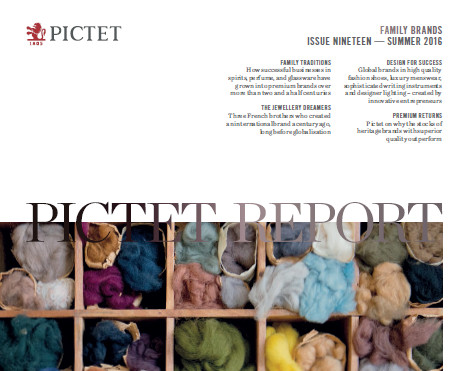Pictet Report Read the full analysis on page 51 of the linked reportIn the Summer 2016 issue of Pictet Report, Pictet managers and analysts set out the megatrends behind the success of premium brands and the financial pillars that make them attractive to investorsPremium brands have proved to be profitable long-term investments, offering strong revenue growth, superior operating margins and robust balance sheets over the long term. There are four fundamental megatrends behind their success in driving returns, whether it be in food, drinks, cosmetics, hotels or autos.The polarisation of demand. Consumers are prepared to pay a lot for brands that produce exceptional and prestigious goods and services, while at the same time wanting to pay very little for common consumer products. This is not just the case for affluent consumers: mid-market consumers, especially in emerging markets, are polarising as well. When the purchasing power of Chinese consumers rises, for example, they will save money to buy a Louis Vuitton key chain or handbag.The growth of tourism, also driven by consumers’ rising purchasing power. People spend a lot on premium brands when they travel, both in volume of items bought and price per item. There are now 100 million Chinese travelling abroad spending huge amounts on premium-branded goods such as perfume, handbags and accessories.
Topics:
Perspectives Pictet considers the following as important: Demand polarisation, luxury brands, Pictet Report, Pictet report summer 2016, Premium brands
This could be interesting, too:
Perspectives Pictet writes Exceptional Swiss hospitality and haute cuisine
Jessica Martin writes Style and status are hallmarks of high-end brands
Perspectives Pictet writes How mobile technology is changing the way we shop
Alexandre Barker writes Mass customisation of breakfast cereals

Read the full analysis on page 51 of the linked report
In the Summer 2016 issue of Pictet Report, Pictet managers and analysts set out the megatrends behind the success of premium brands and the financial pillars that make them attractive to investors
Premium brands have proved to be profitable long-term investments, offering strong revenue growth, superior operating margins and robust balance sheets over the long term. There are four fundamental megatrends behind their success in driving returns, whether it be in food, drinks, cosmetics, hotels or autos.
- The polarisation of demand. Consumers are prepared to pay a lot for brands that produce exceptional and prestigious goods and services, while at the same time wanting to pay very little for common consumer products. This is not just the case for affluent consumers: mid-market consumers, especially in emerging markets, are polarising as well. When the purchasing power of Chinese consumers rises, for example, they will save money to buy a Louis Vuitton key chain or handbag.
- The growth of tourism, also driven by consumers’ rising purchasing power. People spend a lot on premium brands when they travel, both in volume of items bought and price per item. There are now 100 million Chinese travelling abroad spending huge amounts on premium-branded goods such as perfume, handbags and accessories. According to Global Blue, which tracks tax-free shopping data, worldwide luxury spending rose 26% in 2015, and 57% in the case of Chinese tourists.
- Consumers are increasingly searching for an improved lifestyle rather than just a new luxury bag or pair of shoes. They want experiences such as exclusive hotels and adventurous holidays they can spend with others. They also want to go out more with friends to eat and drink—a trend reflected in sales data for premium wines and spirits. A subtrend is the extraordinary growth in sporting goods, as consumers become more health-conscious and have more leisure.
- Consumers faced by enormous choice in an online world are looking for innovation and creativity—they want to be surprised when they spend money. Premium brands engage with this trend by developing new forms of distribution, such as flagship stores and trend-setting digital strategies. Consumers also want innovation and personalisation in goods and services.
In turn, premium brands have three financial pillars that make them particularly attractive to investors. These are: a) high revenue growth through their exposure to affluent and rising middle-class consumers, especially in emerging markets; b) superior operating margins, reflecting premium brands’ pricing power and their control of their distribution systems. In 2015, their average EBITDA margin was 18.7%, compared with 15% for MSCI discretionary consumer companies at large; c) strong cash flow generated by high revenues and operating margins. Many premium brands do not rely on credit to finance their growth or acquisitions. And they can afford to increase dividends and even pay share buybacks.
